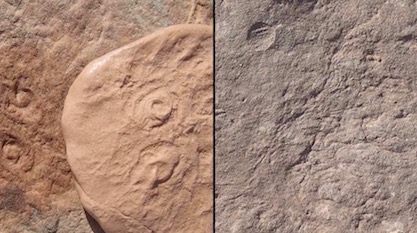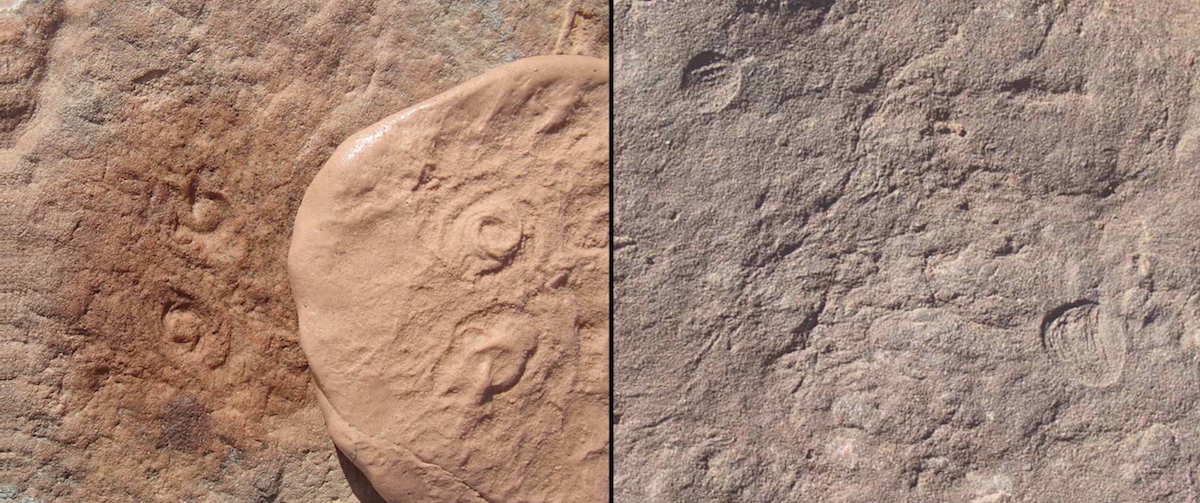 Evolution
Evolution
Trackways Reported in Ediacaran Strata


UC Riverside announced two new fossil members of the Ediacaran biota that lived before the Cambrian explosion. One was named Obamus coronatus after Barack Obama. The other was named Attenborites janeae after David Attenborough. As with all other known members of the Ediacaran fauna, however, neither creature appears to have been capable of movement. Obamus with its groovy skin was embedded in the ocean mat, and Attenborites sat there like a raisin, as the news indicates. These fossils date from somewhere “between 580-540 million years ago.”
Something big happened before another 22 million years on the timeline. Live Science posts an artist’s conception of a large predator swimming the Cambrian seas: Lyrarapax, with complex senses and behaviors, a digestive system, muscular system, nervous system, and reproductive system. Resembling Anomalocaris, the classic Burgess Shale predator, this one was found in Chinese rocks from 518 million years.
What Happened in the Meantime?
The Cambrian explosion did. Some two dozen animal phyla appear in a brief period of 5-6 million years starting around 530 million years ago. Stephen Meyer argues in Darwin’s Doubt that this is too brief a period to expect blind Darwinian process to come up with complex systems. Moreover, the appearance of hierarchical complexity, including networks of integrated organs and the genetic information to make them and put them together, speaks of intelligent design.
Evolutionists would dearly love to find bilaterian animals emerging slowly from the lazy “still life” world of the Ediacaran period, because they believe it would soften the Cambrian explosion. Some point to the “small shelly fossils” that appear in some early Cambrian and late Precambrian rocks around 543 million years ago, but as Meyer and Casey Luskin argue in Debating Darwin’s Doubt (Chapters 13-14), most paleontologists do not believe those have any phylogenetic connection to the Cambrian animals. But now, have scientists found evidence of Ediacaran movement?
Trace fossils, or ichnofossils, are impressions in rock showing possible animal activity without direct evidence of the animal itself. They include features like trackways, burrows, and bioturbation (churning of layers by animal diggings). When distinct enough, trackways can be used to identify the species of animal. Think of tracks on sand dunes made by lizards, snakes or beetles. That’s easy, because we can watch what animal makes the tracks. The further back in time one goes, however, the more difficult the identification. What happens so far back that one cannot be sure animals even existed?
Moving Rocks
Care must be taken to ensure that alleged trackways are not products of inanimate forces. The famous moving rocks on Death Valley’s Racetrack Playa show that elaborate “trackways” can be made by wind carrying rocks embedded in ice rafts. Underwater currents pushing pebbles against a seafloor could also theoretically create false trackways.
The case for trackways can be strengthened if they are parallel and distinctive enough to show individual footprints. In Science Advances, five Chinese scientists have reported “Late Ediacaran trackways produced by bilaterian animals with paired appendages.” These date from the latest member of the Ediacaran period:
Ediacaran trace fossils provide key paleontological evidence for the evolution of early animals and their behaviors. Thus far, however, this fossil record has been limited to simple surface trails and relatively shallow burrows. We report possible trackways, preserved in association with burrows, from the terminal Ediacaran Shibantan Member (ca. 551 to ca. 541 million years ago) in the Yangtze Gorges area of South China. These trace fossils represent the earliest known trackways. They consist of two rows of imprints arranged in poorly organized series or repeated groups. These trackways may have been produced by bilaterian animals with paired appendages, although the phylum-level phylogenetic affinity of the trace makers remains unknown. It is possible that the trackways and associated burrows were produced by the same trace maker, indicating a complex behavior involving both walking and burrowing. Together, these trackways and burrows mark the arrival of a new era characterized by an increasing geobiological footprint of bilaterian animals.
The BBC News has a photo of one of the two trackways, saying “The identity of the creature that made the 546-million-year-old tracks is still unknown, but they come from the period when the earliest animals are thought to have evolved.” Live Science says, “The new findings suggest animals evolved primitive ‘arms’ and ‘legs’ earlier than previously thought.” Not everyone thinks that animals evolved, so we can disregard that bit of fake science.
Not Definitive Words
Are you convinced from the photo? The article quotes one of the paper’s authors stating that these trackways “The new fossils are probably up to 10 million years older” than previously identified footprints. “Probably” and “up to” are not definitive words. Just as probably, these alleged trackways are young enough to overlap with trace fossils that were already known.
In the open-access paper, you can see the two trackways they found and the three possible burrows. They measure from 70 to 90 mm long and from 14 to 16 mm wide. The tracks are “not as regularly arranged as most Phanerozoic trackways” and are admittedly vague. Some parallelism is evident, but not anything that looks like footprints. One could imagine pebbles rolling and creating the tracks, but the association with possible burrows, and the fact that the “tracks” come in pairs that turn together supports their contention. The interpretation, however, admittedly remains speculative:
Although the exact identity of the trace maker of the Shibantan trackways is difficult to determine in the absence of body remains at the end of the trackways, we suggest that the trace maker was probably a bilaterian animal with paired appendages. The discrete tracks are distinct from trails or burrows made by peristaltic movement of legless worms and indicate that the trace maker instead used paired appendages for locomotion. Both trackways lack a continuous medial drag mark, and TW2 overpasses the burrows UB1 and UB2 without cutting through them, suggesting that the trace maker may have had supporting appendages to elevate the animal body above the sediment surface (if the trace fossils are overtracks) or could pierce a microbial mat (if the trace fossils are undertracks). This style of movement is apparently comparable to arthropod locomotion using jointed appendages. We consider an arthropod-like trace maker possible, although it is not beyond the realm of possibility that the Shibantan trackways may have been made by other animals analogous to modern annelids, onychophorans, or tardigrades, which all have appendages. We emphasize that there is no compelling evidence to phylogenetically place the Shibantan trace maker within the total-group Panarthropoda (or total-group Annelida, for that matter), considering that appendages may have evolved convergently in several groups of bilaterians or may have been present in the last common ancestor of bilaterians. The irregular arrangement of tracks in the Shibantan trackways may be taken as evidence that the movement of their trace maker’s appendages was poorly coordinated and is distinct from the highly coordinated metachronal rhythm typical of modern arthropods. Thus, modern animals such as arthropods are regarded as interpretive analogs, but not necessarily phylogenetic relatives, of the Shibantan trace maker. All that can be said about the Shibantan trackways maker is that it is probably a bilaterian with paired appendages.
Analyzing the claims, here are some observations about the strength of this evidence.
- The trackways date from the latest part of the Ediacaran period that overlaps with known trace fossils.
- The authors are tentative about the claims, saying they are “possible trackways” that “may have been produced” by bilaterian animals.
- The creature that made them is unknown.
- The sample is small. There are only two potential trackways in the formation, along with a few possible burrows.
- Other physical forces could be capable of making the alleged trackways.
- The trackways are short and not perfectly parallel.
- No other Ediacaran creatures are known to have left trackways. The earliest ichnofossils indicating motion date from the “small shelly fossils” period at around 543 million years.
- Trackways have not been reported from any other Ediacaran stratum.
Slim Evidence
Given these caveats, the evidence they were made by Precambrian animals appears slim. Let’s give them the benefit of the doubt, though, and test the idea that some moving creature made them. If it was a bilaterian animal, it appears abruptly in the record without transitional forms. If it was not a bilaterian, we already knew there were some phyla of animals before the main Cambrian explosion — certainly sponges and possibly mollusks — that might have been present. But if those were the track-makers, why are these alleged trackways not found all over the world? If it was an Ediacaran creature that could move a little, that doesn’t help evolutionists, because members of that group are not believed to be related to the Cambrian animals.
Even if we gave evolutionists all the benefit of the doubt, and accepted for the sake of argument that an arthropod or annelid made these tracks 20 million years earlier than any previously seen, at 551 million years old (the oldest possible date for the tracks), it still is not enough time for natural selection to build the animal body plans that are first seen in the Cambrian. In Debating Darwin’s Doubt (pp. 158-159), Meyer says,
…even a duration of 25 million years would not appreciably diminish the problem facing contemporary evolutionary theory. In the first place, 25 million years would not provide enough opportunities for the mutation/selection process to search more than a tiny fraction of the relevant sequence space necessary to produce even a single new gene or functional protein. Second, the calculated waiting times required to evolve multi-mutation features also suggest that even pushing the beginning of the Cambrian explosion back to the first appearance of the small shelly fossils, as [Charles] Marshall suggests we should, does not provide enough time for many complex biological features to evolve. Marshall does not attempt to refute these experimentally-based quantitative arguments. Consequently, it’s hard to see how my decision not to make more of these enigmatic small shelly fossils in any way undermines the main arguments of Darwin’s Doubt.
Clearly, adding 8 million more years of chance will not suffice, either.
It’s not wise to build a case on one instance. The weak suggestions in this paper do not explain two dozen body plans appearing in a geological instant in the Cambrian. If a complex animal was present in the late Ediacaran capable of making trackways, its body should show up somewhere. We would like to see that rather than a couple of squiggles in a Chinese rock.
Photo: Obamus coronatus and Attenborites janeae, left and right, respectively, via UC Riverside.
